Coastal Flooding Hazards in Northern Portugal: A Practical Large-Scale Evaluation of Total Water Levels and Swash Regimes
Abstract
1. Introduction
2. Materials and Methods
2.1. Coastal Topography Data and Geoprocessing
2.2. Ocean Variables and Numerical Modelling
2.3. Sea-Level
2.4. Runup Calculation
2.5. Flooding Records
2.6. Swash Regimes
- The swash regime () does not reach the dune toe, thereby confining the swash to the beach area alone. This condition indicates the minimal level of coastal storm flooding hazard, maintaining a safe corridor for access or amenity between the dune and shoreline.
- Collision regime (): When the TWL impacts the dune, the adjacent beach area may be intermittently or continuously submerged. This scenario constitutes the second level of flooding hazard, eliminating the dry corridor between the dune and shoreline.
- Overwash Regime (): When the dune crest is intermittently overtopped, potentially exposing assets and property behind the dune crest, or defense structure, to flooding. This represents a high level of coastal flooding hazard.
3. Results
3.1. Geoprocessing
3.2. Total Water Level and Swash Regimes
4. Discussion
5. Conclusions
Author Contributions
Funding
Data Availability Statement
Conflicts of Interest
References
- Sebastião, P.; Guedes Soares, C.; Booij, N. Wave Hindcasting off the Coast of Portugal. Coast. Eng. 2000, 40, 411–425. [Google Scholar] [CrossRef]
- Barros, J.L.; Santos, P.P.; Tavares, A.O.; Freire, P.; Fortunato, A.B.; Rilo, A.; Oliveira, F.S.B.F. The Complexity of the Coastal Zone: Definition of Typologies in Portugal as a Contribution to Coastal Disaster Risk Reduction and Management. Int. J. Disaster Risk Reduct. 2023, 86, 103556. [Google Scholar] [CrossRef]
- Barros, J.L.; Santos, P.P.; Tavares, A.O.; Freire, P. Inundações e Galgamentos Costeiros: Uma Base de Dados de Ocorrências e Seus Impactos Para a Costa Continental Portuguesa Entre 1980 e 2018. In O Compromisso da Geografia Para Territórios em Mudança. Livro de Atas do XIII Congresso da Geografia Portuguesa; Associação Portuguesa de Geógrafos: Lisbon, Protugal, 2022. [Google Scholar]
- Antunes, C.; Taborda, R. Sea Level at Cascais Tide Gauge: Data, Analysis and Results. J. Coast. Res. 2009, 56, 218–222. [Google Scholar]
- Vitousek, S.; Barnard, P.L.; Fletcher, C.H.; Frazer, N.; Erikson, L.; Storlazzi, C.D. Doubling of Coastal Flooding Frequency within Decades Due to Sea-Level Rise. Sci. Rep. 2017, 7, 1399. [Google Scholar] [CrossRef] [PubMed]
- Green, J.; Haigh, I.; Quinn, N.; Neal, J.; Wahl, T.; Wood, M.; Eilander, D.; De Ruiter, M.; Ward, P.; Camus, P. Review Article: A Comprehensive Review of Compound Flooding Literature with a Focus on Coastal and Estuarine Regions. EGUsphere 2024. [Google Scholar] [CrossRef]
- de Magalhães Oliveira Martins, B.T. Caracterização da Evolução Recente da Linha de Costa e Identificação de Zonas Vulneráveis no Trecho Costeiro Caminha-Espinho. Ph.D. Thesis, Universidade do Porto, Porto, Portugal, 2013. [Google Scholar]
- Agência Portuguesa do Ambiente. Programas da Orla Costeira; APA: Amadora, Portugal, 2021. [Google Scholar]
- Carneiro-Barros, J.E.; Plomaritis, T.A.; Fazeres-Ferradosa, T.; Rosa-Santos, P.; Taveira-Pinto, F. Coastal Flood Mapping with Two Approaches Based on Observations at Furadouro, Northern Portugal. Remote Sens. 2023, 15, 5215. [Google Scholar] [CrossRef]
- Pinto, I.M.P. Galgamentos e Inundações Costeiras Na Frente Urbana Do Furadouro-Concelho de Ovar. Master’s Thesis, Universidade do Porto, Porto, Portugal, 2022. [Google Scholar]
- Turner, I.L.; Leaman, C.K.; Harley, M.D.; Thran, M.C.; David, D.R.; Splinter, K.D.; Matheen, N.; Hansen, J.E.; Cuttler, M.V.W.; Greenslade, D.J.M.; et al. A Framework for National-Scale Coastal Storm Hazards Early Warning. Coast. Eng. 2024, 192, 104571. [Google Scholar] [CrossRef]
- Stockdon, H.F.; Long, J.W.; Palmsten, M.L.; Van Der Westhuysen, A.; Doran, K.S.; Snell, R.J. Operational Forecasts of Wave-Driven Water Levels and Coastal Hazards for US Gulf and Atlantic Coasts. Commun. Earth Environ. 2023, 4, 169. [Google Scholar] [CrossRef]
- Bertin, X.; de Bakker, A.; van Dongeren, A.; Coco, G.; André, G.; Ardhuin, F.; Bonneton, P.; Bouchette, F.; Castelle, B.; Crawford, W.C.; et al. Infragravity Waves: From Driving Mechanisms to Impacts. Earth-Sci. Rev. 2018, 177, 774–799. [Google Scholar] [CrossRef]
- Lashley, C.H.; Jonkman, S.N.; Van Der Meer, J.; Bricker, J.D.; Vuik, V. The Influence of Infragravity Waves on the Safety of Coastal Defences: A Case Study of the Dutch Wadden Sea. Nat. Hazards Earth Syst. Sci. 2022, 22, 1–22. [Google Scholar] [CrossRef]
- Leijnse, T.W.B.; van Ormondt, M.; van Dongeren, A. Estimating Nearshore Infragravity Wave Conditions at Large Spatial Scales. Front. Mar. Sci. 2024, 11, 1355095. [Google Scholar] [CrossRef]
- Parker, K.; Erikson, L.; Thomas, J.; Nederhoff, K.; Barnard, P.; Muis, S. Relative Contributions of Water-Level Components to Extreme Water Levels along the US Southeast Atlantic Coast from a Regional-Scale Water-Level Hindcast. Nat. Hazards 2023, 117, 2219–2248. [Google Scholar] [CrossRef]
- Gomes Da Silva, P.; Coco, G.; Garnier, R.; Klein, A.H.F. On the Prediction of Runup, Setup and Swash on Beaches. Earth-Sci. Rev. 2020, 204, 103148. [Google Scholar] [CrossRef]
- Villarroel-Lamb, D.; Williams, A.H. Quantifying Wave Runup in Data-Sparse Locations for Planning. West Indian J. Eng. 2022, 44, 58–69. [Google Scholar] [CrossRef]
- Stockdon, H.F.; Holman, R.A.; Howd, P.A.; Sallenger, A.H. Empirical Parameterization of Setup, Swash, and Runup. Coast. Eng. 2006, 53, 573–588. [Google Scholar] [CrossRef]
- Donnelly, C.; Wamsley, T.V.; Kraus, N.C.; Larson, M.; Hanson, H. Morphologic Classification of Coastal Overwash. In Proceedings of the Coastal Engineering 2006; World Scientific Publishing Company: San Diego, CA, USA, 2007; pp. 2805–2817. [Google Scholar]
- Plomaritis, T.A.; Ferreira, Ó.; Costas, S. Regional Assessment of Storm Related Overwash and Breaching Hazards on Coastal Barriers. Coast. Eng. 2018, 134, 124–133. [Google Scholar] [CrossRef]
- Ferreira, Ó.; Plomaritis, T.A.; Costas, S. Process-Based Indicators to Assess Storm Induced Coastal Hazards. Earth-Sci. Rev. 2017, 173, 159–167. [Google Scholar] [CrossRef]
- Gallien, T.; Kalligeris, N.; Delisle, M.-P.; Tang, B.-X.; Lucey, J.; Winters, M. Coastal Flood Modeling Challenges in Defended Urban Backshores. Geosciences 2018, 8, 450. [Google Scholar] [CrossRef]
- De Santiago, I.; Plomaritis, T.A.; Avalos, D.; Garnier, R.; Abalia, A.; Epelde, I.; Liria, P. Comparison of Wave Overtopping Estimation Models for Urban Beaches. Towards an Early Warning System on the Basque Coast. Sci. Total Environ. 2024, 912, 168783. [Google Scholar] [CrossRef]
- Vousdoukas, M.I.; Mentaschi, L.; Voukouvalas, E.; Verlaan, M.; Jevrejeva, S.; Jackson, L.P.; Feyen, L. Global Probabilistic Projections of Extreme Sea Levels Show Intensification of Coastal Flood Hazard. Nat. Commun. 2018, 9, 2360. [Google Scholar] [CrossRef]
- Hinkel, J.; Feyen, L.; Hemer, M.; Le Cozannet, G.; Lincke, D.; Marcos, M.; Mentaschi, L.; Merkens, J.L.; de Moel, H.; Muis, S.; et al. Uncertainty and Bias in Global to Regional Scale Assessments of Current and Future Coastal Flood Risk. Earth’s Future 2021, 9, e2020EF001882. [Google Scholar] [CrossRef]
- Palmsten, M.L.; Holman, R.A. Laboratory Investigation of Dune Erosion Using Stereo Video. Coast. Eng. 2012, 60, 123–135. [Google Scholar] [CrossRef]
- Majidi, A.G.; Ramos, V.; Calheiros-Cabral, T.; Neves, L.D.; Rosa-Santos, P.; Taveira-Pinto, F. Integrated Assessment of Offshore Wind and Wave Power Resources in Mainland Portugal. Energy 2024, 308, 132944. [Google Scholar] [CrossRef]
- Majidi, A.G.; Ramos, V.; Amarouche, K.; Rosa Santos, P.; Das Neves, L.; Taveira-Pinto, F. Assessing the Impact of Wave Model Calibration in the Uncertainty of Wave Energy Estimation. Renew. Energy 2023, 212, 415–429. [Google Scholar] [CrossRef]
- Van Ormondt, M.; Nederhoff, K.; Van Dongeren, A. Delft Dashboard: A Quick Set-up Tool for Hydrodynamic Models. J. Hydroinformatics 2020, 22, 510–527. [Google Scholar] [CrossRef]
- Giaremis, S.; Nader, N.; Dawson, C.; Kaiser, C.; Nikidis, E.; Kaiser, H. Storm Surge Modeling in the AI Era: Using LSTM-Based Machine Learning for Enhancing Forecasting Accuracy. Coast. Eng. 2024, 191, 104532. [Google Scholar] [CrossRef]
- Holman, R.A. Extreme Value Statistics for Wave Run-up on a Natural Beach. Coast. Eng. 1986, 9, 527–544. [Google Scholar] [CrossRef]
- Nielsen, P.; Hanslow, D.J. Wave Runup Distributions on Natural Beaches. J. Coast. Res. 1991, 7, 1139–1152. [Google Scholar]
- Ruggiero, P.; Komar, P.D.; McDougal, W.G.; Marra, J.J.; Beach, R.A. Wave Runup, Extreme Water Levels and the Erosion of Properties Backing Beaches. J. Coast. Res. 2001, 17, 407–419. [Google Scholar]
- Vousdoukas, M.I.; Wziatek, D.; Almeida, L.P. Coastal Vulnerability Assessment Based on Video Wave Run-up Observations at a Mesotidal, Steep-Sloped Beach. Ocean. Dyn. 2012, 62, 123–137. [Google Scholar] [CrossRef]
- Leaman, C.; Beuzen, T.; Goldstein, E.B. Chrisleaman/Py-Wave-Runup: V0.1.10 2020. Available online: https://py-wave-runup.readthedocs.io/en/latest/ (accessed on 1 December 2023).
- Sallenger, A.H. Storm Impact Scale for Barrier Islands. J. Coast. Res. 2000, 16, 890–895. [Google Scholar]
- Leaman, C.K.; Harley, M.D.; Splinter, K.D.; Thran, M.C.; Kinsela, M.A.; Turner, I.L. A Storm Hazard Matrix Combining Coastal Flooding and Beach Erosion. Coast. Eng. 2021, 170, 104001. [Google Scholar] [CrossRef]
- Lemos, G.; Soares, P.M.M.; Simões, R.; Antunes, C.; Bosnic, I.; Pinto, C. A Physical Climate Storyline for the Hercules Storm in Portugal: Extreme Coastal Flooding in Southwestern Europe under a Changing Climate. Sci. Total Environ. 2025, 971, 179050. [Google Scholar] [CrossRef]
- Santos, Â.; Mendes, S.; Corte-Real, J. Impacts of the storm Hercules in Portugal. Finisterra 2014, 49, 197–220. [Google Scholar] [CrossRef]
- Haigh, I.D.; Pickering, M.D.; Green, J.A.M.; Arbic, B.K.; Arns, A.; Dangendorf, S.; Hill, D.F.; Horsburgh, K.; Howard, T.; Idier, D.; et al. The Tides They Are A-Changin’: A Comprehensive Review of Past and Future Nonastronomical Changes in Tides, Their Driving Mechanisms, and Future Implications. Rev. Geophys. 2020, 58, e2018RG000636. [Google Scholar] [CrossRef]
- Marcos, M.; Rohmer, J.; Vousdoukas, M.; Mentaschi, L.; Le, C.G.; Amores, A. Increased Extreme Coastal Water Levels Due to the Combined Action of Storm Surges and Wind-Waves. Geophys. Res. Lett. 2019, 46, 4356–4364. [Google Scholar] [CrossRef]
- Needham, H.F.; Keim, B.D.; Sathiaraj, D. A Review of Tropical Cyclone-Generated Storm Surges: Global Data Sources, Observations, and Impacts. Rev. Geophys. 2015, 53, 545–591. [Google Scholar] [CrossRef]
- Dodet, G.; Melet, A.; Ardhuin, F.; Bertin, X.; Idier, D.; Almar, R. The Contribution of Wind-Generated Waves to Coastal Sea-Level Changes. Surv. Geophys. 2019, 40, 1563–1601. [Google Scholar] [CrossRef]
- Poseiro, P.; Reis, M.T.; Fortes, C.J.E.M.; Lopes, E.M.; Sabino, A.; Rodrigues, A. Aplicação do Sistema de Previsão e Alerta de Inundações HIDRALERTA: Caso de Estudo da Costa da Caparica. In Proceedings of the 3as Jornadas de Engenharia Hidrográfica, Lisbon, Portugal, 24–26 June 2014. [Google Scholar] [CrossRef]
- Manz, A.; Zózimo, A.C.; Garzon, J.L. Application of SWASH to Compute Wave Overtopping in Ericeira Harbour for Operational Purposes. J. Mar. Sci. Eng. 2022, 10, 1881. [Google Scholar] [CrossRef]
- Fortes, C.J.E.M.; Reis, R.; Reis, M.T.; Poseiro, P.; Craveiro, J.; Santos, J.A. Risco de galgamento nas estruturas marítimas da praia da Vitória: Resultados do sistema HIDRALERTA. Territorium 2015, 22, 103–117. [Google Scholar] [CrossRef][Green Version]
- Antunes, C.; Lemos, G. A Probabilistic Approach to Combine Sea Level Rise, Tide and Storm Surge into Representative Return Periods of Extreme Total Water Levels: Application to the Portuguese Coastal Areas. Estuar. Coast. Shelf Sci. 2025, 313, 109060. [Google Scholar] [CrossRef]
- Lemos, G.; Bosnic, I.; Antunes, C.; Vousdoukas, M.; Mentaschi, L.; Espírito Santo, M.; Ferreira, V.; Soares, P.M.M. The Future of the Portuguese (SW Europe) Most Vulnerable Coastal Areas under Climate Change–Part II: Future Extreme Coastal Flooding from Downscaled Bias Corrected Wave Climate Projections. Ocean. Eng. 2024, 310, 118448. [Google Scholar] [CrossRef]
- Lemos, G.; Bosnic, I.; Antunes, C.; Vousdoukas, M.; Mentaschi, L.; Soares, P.M.M. The Future of the Portuguese (SW Europe) Most Vulnerable Coastal Areas under Climate Change–Part I: Performance Evaluation and Shoreline Evolution from a Downscaled Bias Corrected Wave Climate Ensemble. Ocean. Eng. 2024, 302, 117661. [Google Scholar] [CrossRef]
- Garcia, T.; Ferreira, O.; Matias, A.; Dias, J.A. Coastal Hazards Representation for Praia Do Barril (Algarve, Portugal). J. Coast. Res. 2005, 49, 28–33. [Google Scholar]
- Beuzen, T.; Goldstein, E.; Splinter, K. Ensemble Models from Machine Learning: An Example of Wave Runup and Coastal Dune Erosion. Nat. Hazards Earth Syst. Sci. 2019, 19, 2295–2309. [Google Scholar] [CrossRef]
- Bujak, D.; Ilic, S.; Miličević, H.; Carević, D. Wave Runup Prediction and Alongshore Variability on a Pocket Gravel Beach under Fetch-Limited Wave Conditions. J. Mar. Sci. Eng. 2023, 11, 614. [Google Scholar] [CrossRef]
- Kralj, E.; Kumer, P.; Meulenberg, C.J.W. Coastal Flood Risk Assessment: An Approach to Accurately Map Flooding through National Registry-Reported Events. J. Mar. Sci. Eng. 2023, 11, 2290. [Google Scholar] [CrossRef]
- Rilo, A.; Tavares, A.O.; Freire, P.; Zêzere, J.L.; Haigh, I.D. Improving Estuarine Flood Risk Knowledge through Documentary Data Using Multiple Correspondence Analysis. Water 2022, 14, 3161. [Google Scholar] [CrossRef]
- Molinari, D.; De Bruijn, K.; Castillo, J.; Aronica, G.; Bouwer, L. Validation of Flood Risk Models: Current Practice and Possible Improvements. Int. J. Disaster Risk Reduct. 2018, 33, 441–448. [Google Scholar] [CrossRef]
- Almar, R.; Ranasinghe, R.; Bergsma, E.W.J.; Diaz, H.; Melet, A.; Papa, F.; Vousdoukas, M.; Athanasiou, P.; Dada, O.; Almeida, L.P.; et al. A Global Analysis of Extreme Coastal Water Levels with Implications for Potential Coastal Overtopping. Nat. Commun. 2021, 12, 3775. [Google Scholar] [CrossRef]
- Leijnse, T. SFINCS Documentation. Available online: https://sfincs.readthedocs.io/en/latest/ (accessed on 1 December 2024).
- Leijnse, T.; Van Ormondt, M.; Nederhoff, K.; Van Dongeren, A. Modeling Compound Flooding in Coastal Systems Using a Computationally Efficient Reduced-Physics Solver: Including Fluvial, Pluvial, Tidal, Wind- and Wave-Driven Processes. Coast. Eng. 2021, 163, 103796. [Google Scholar] [CrossRef]

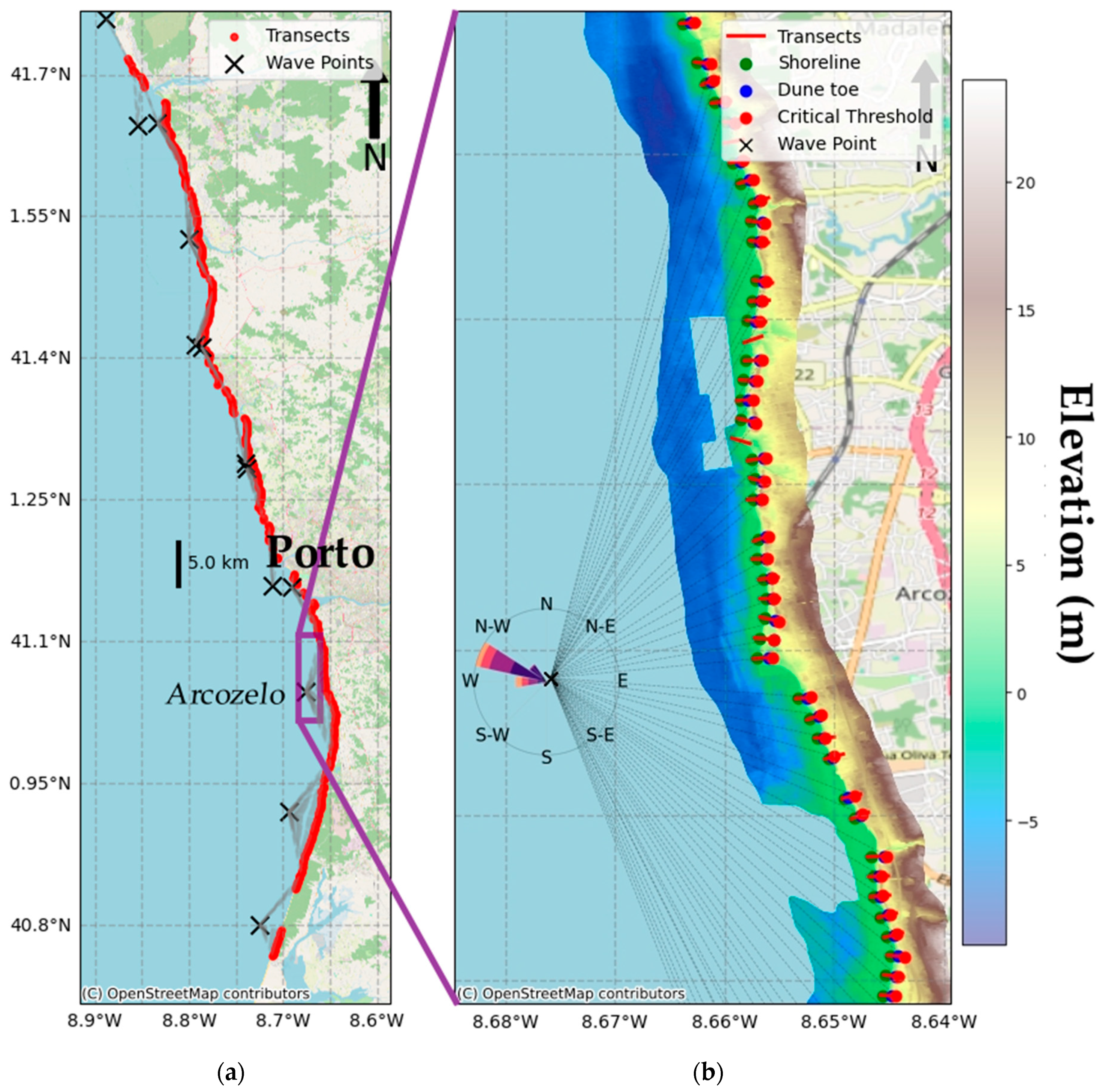
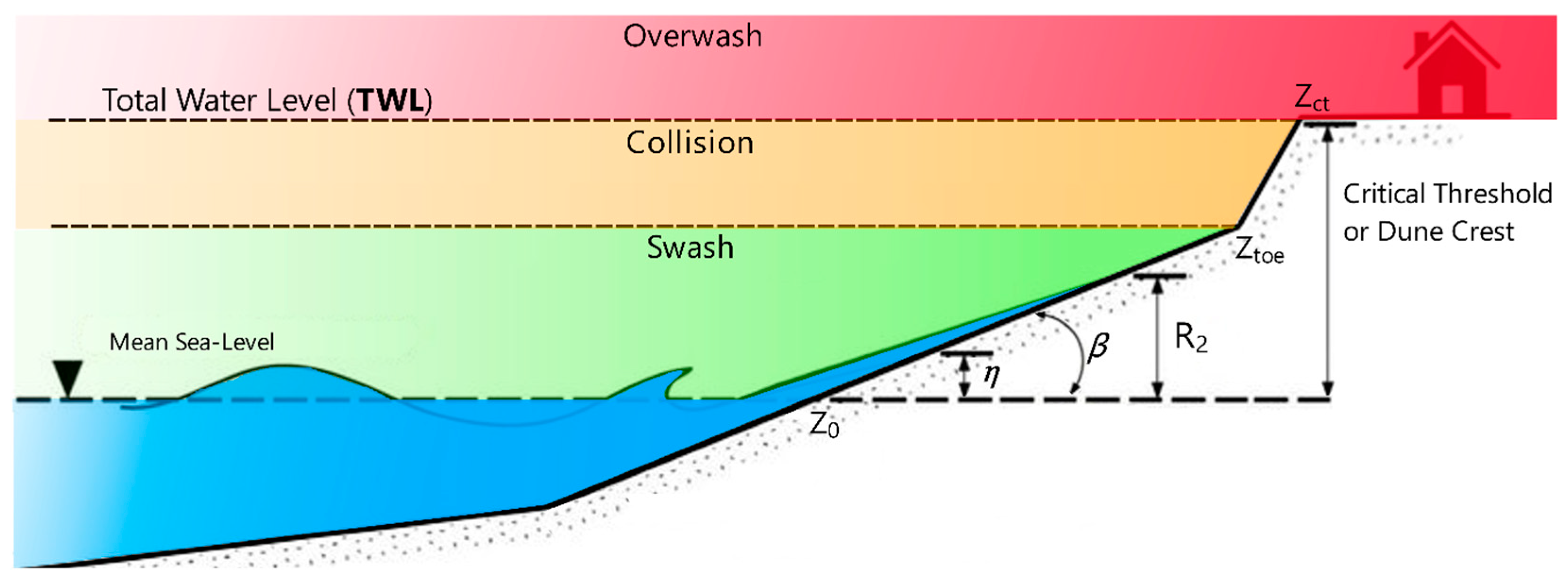
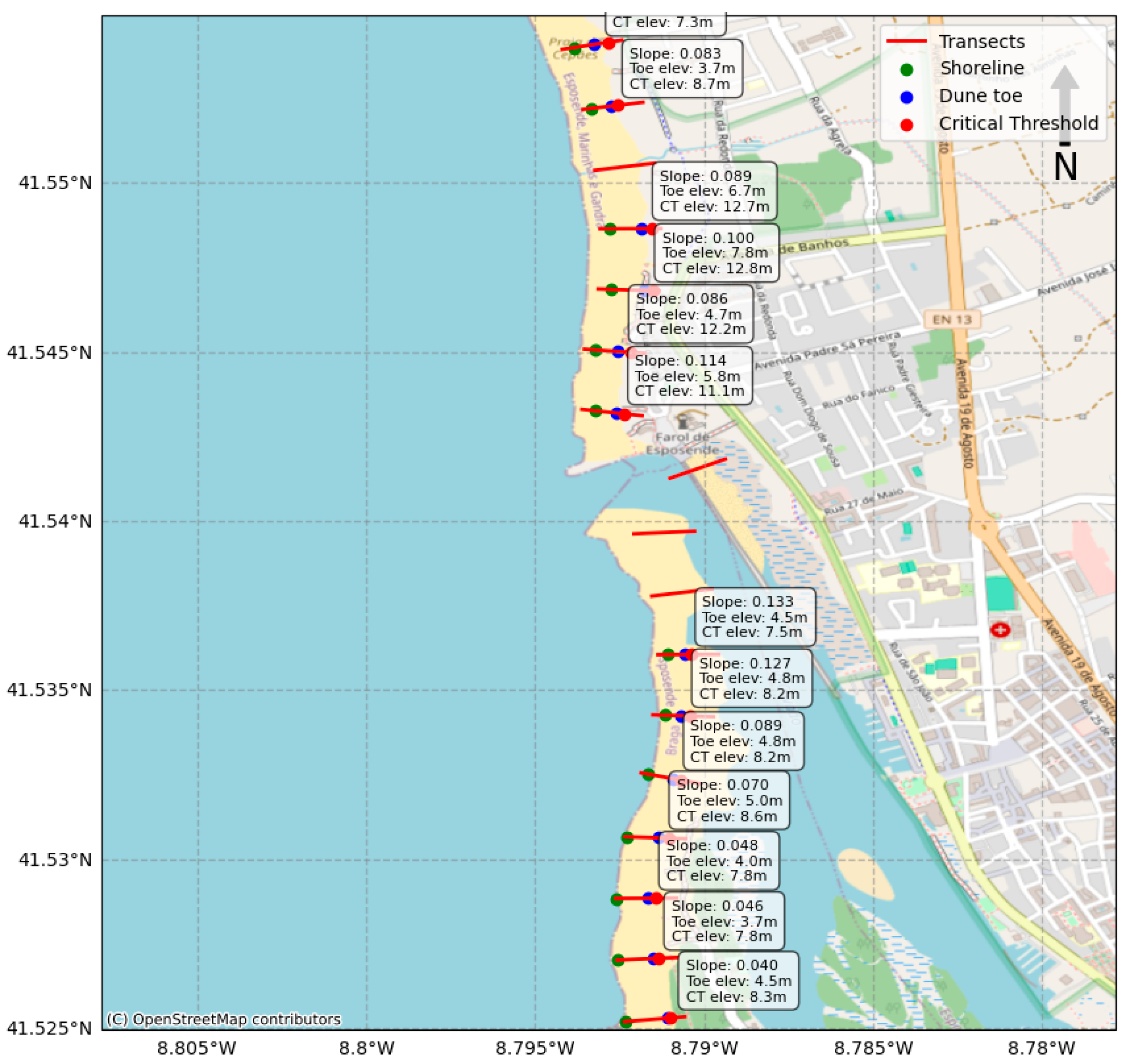
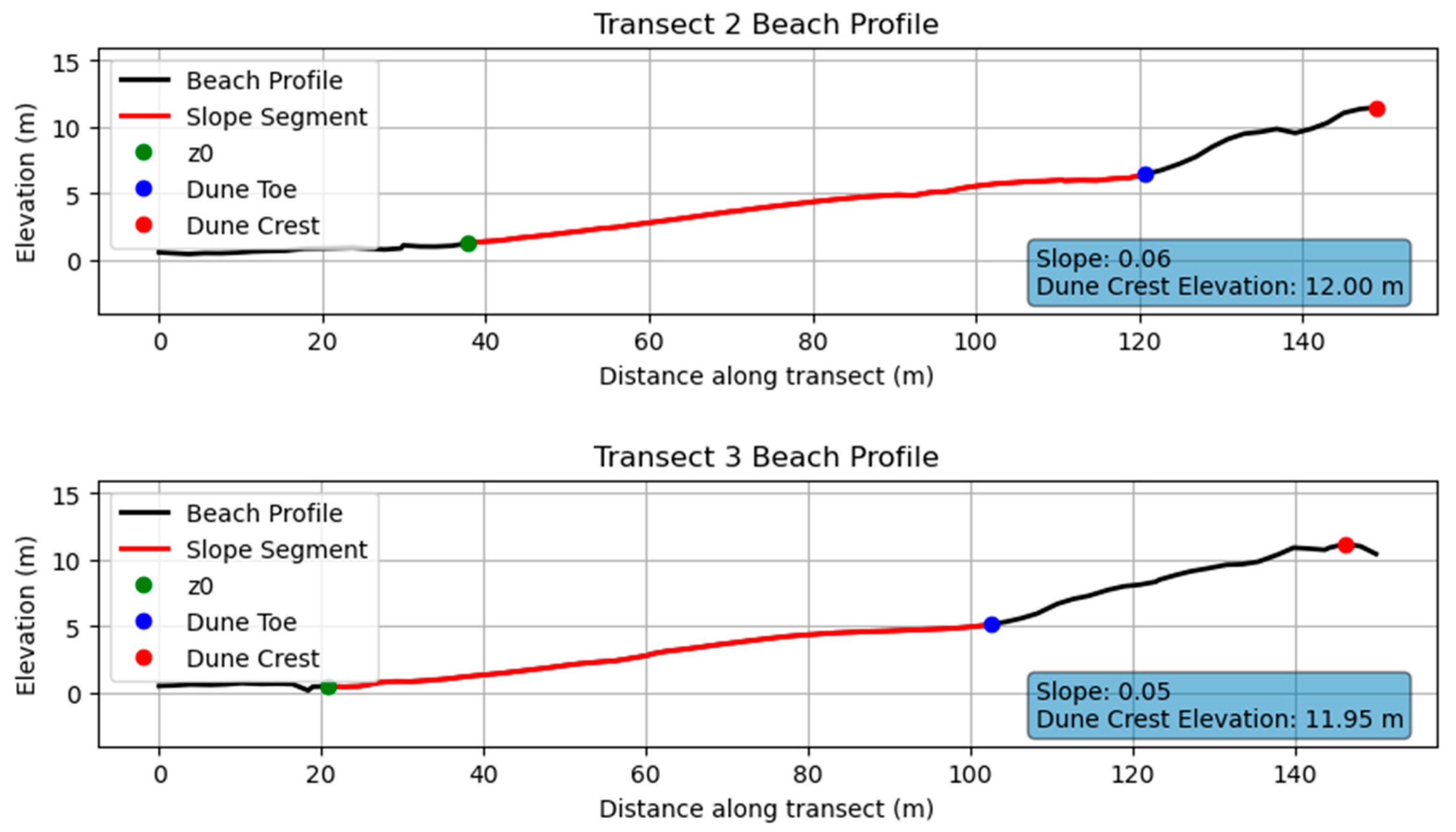
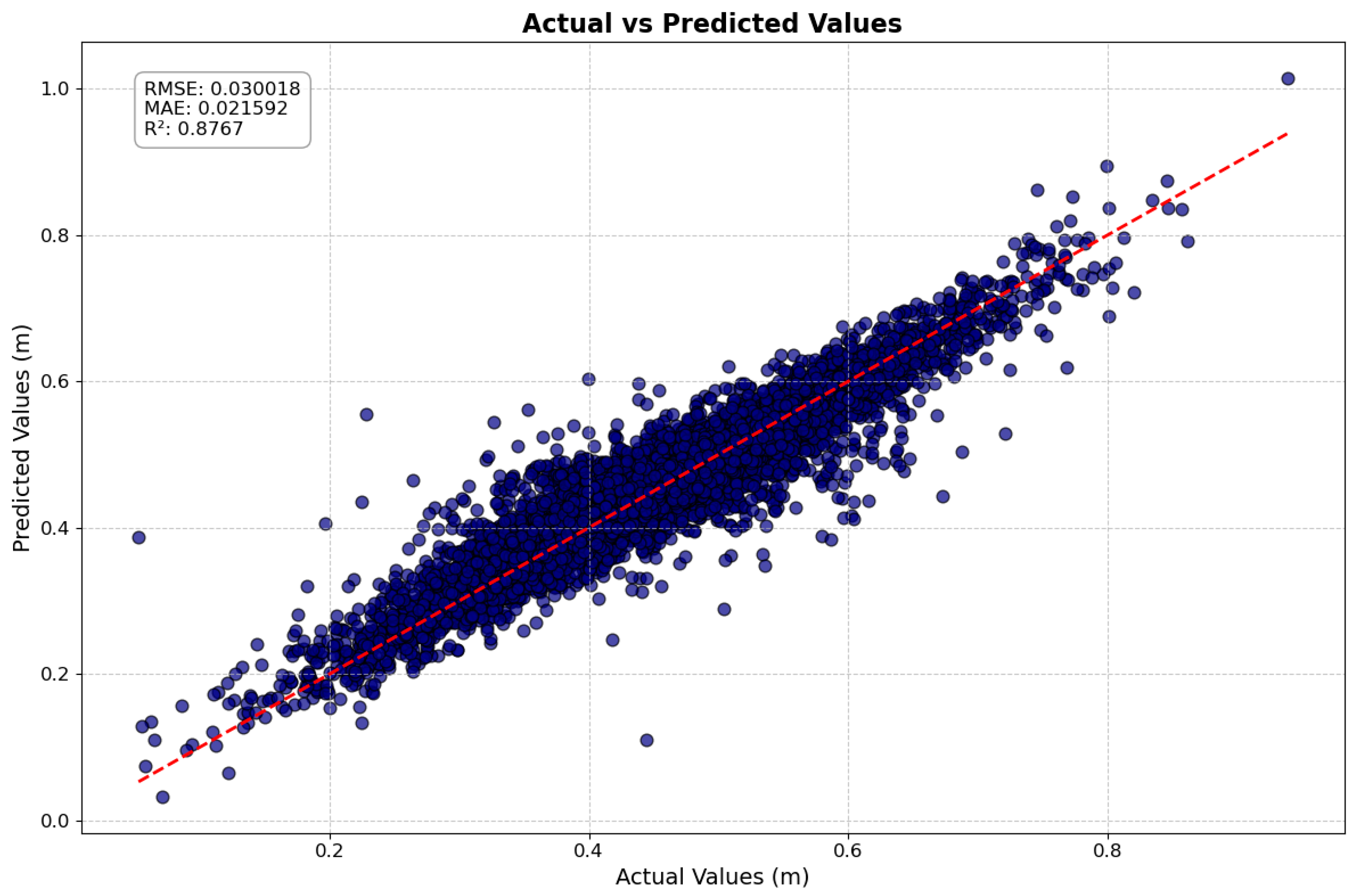
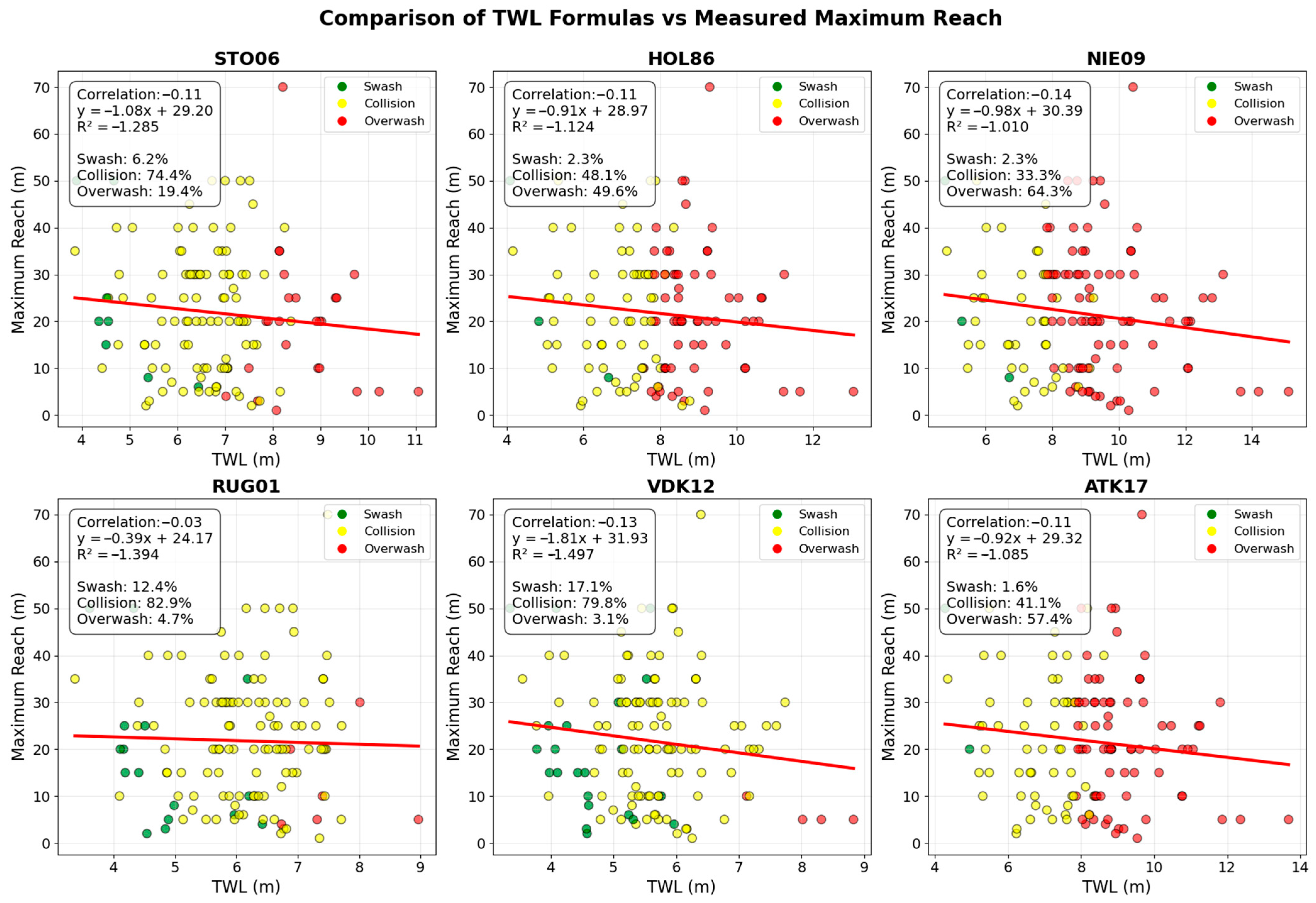
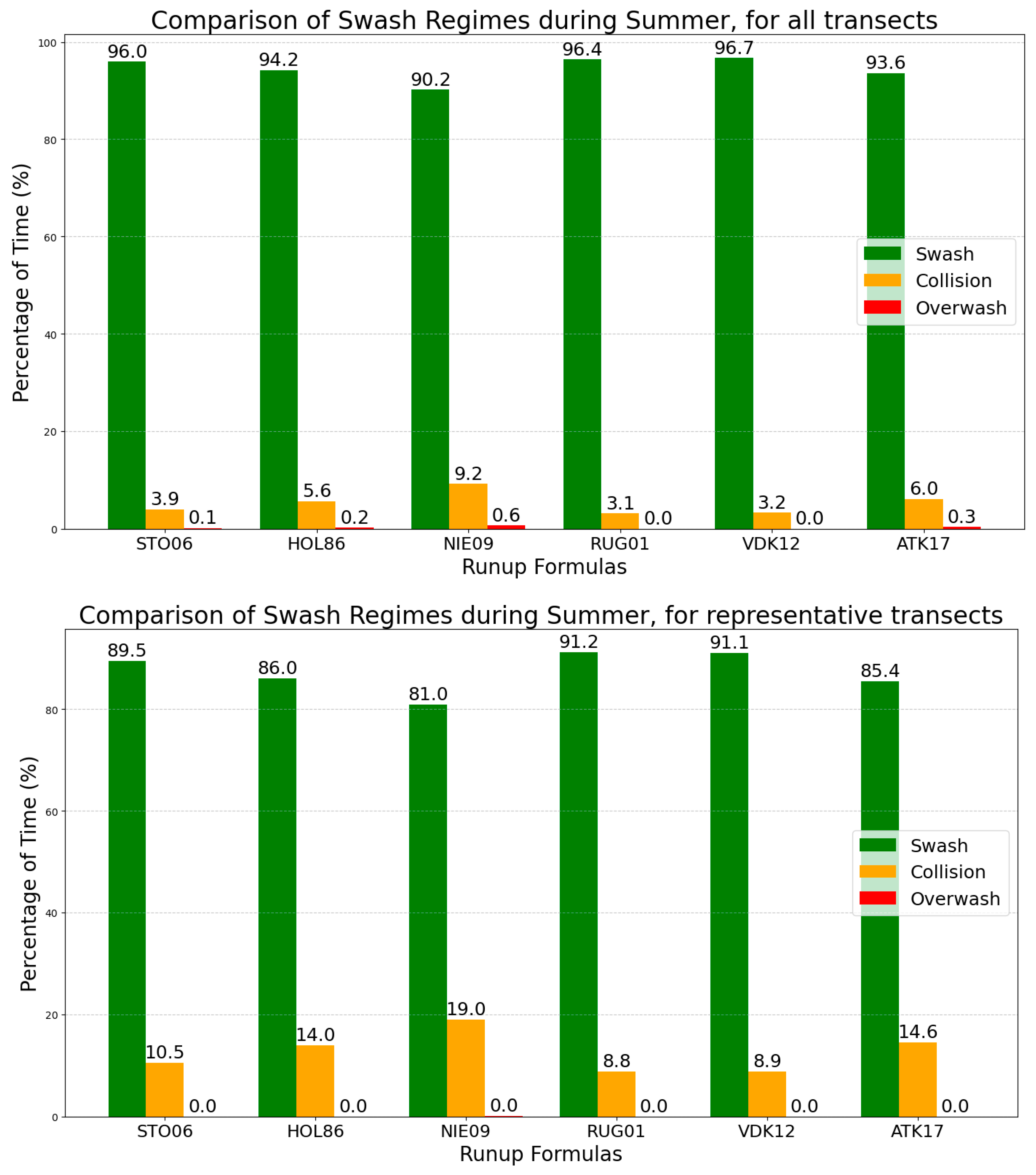
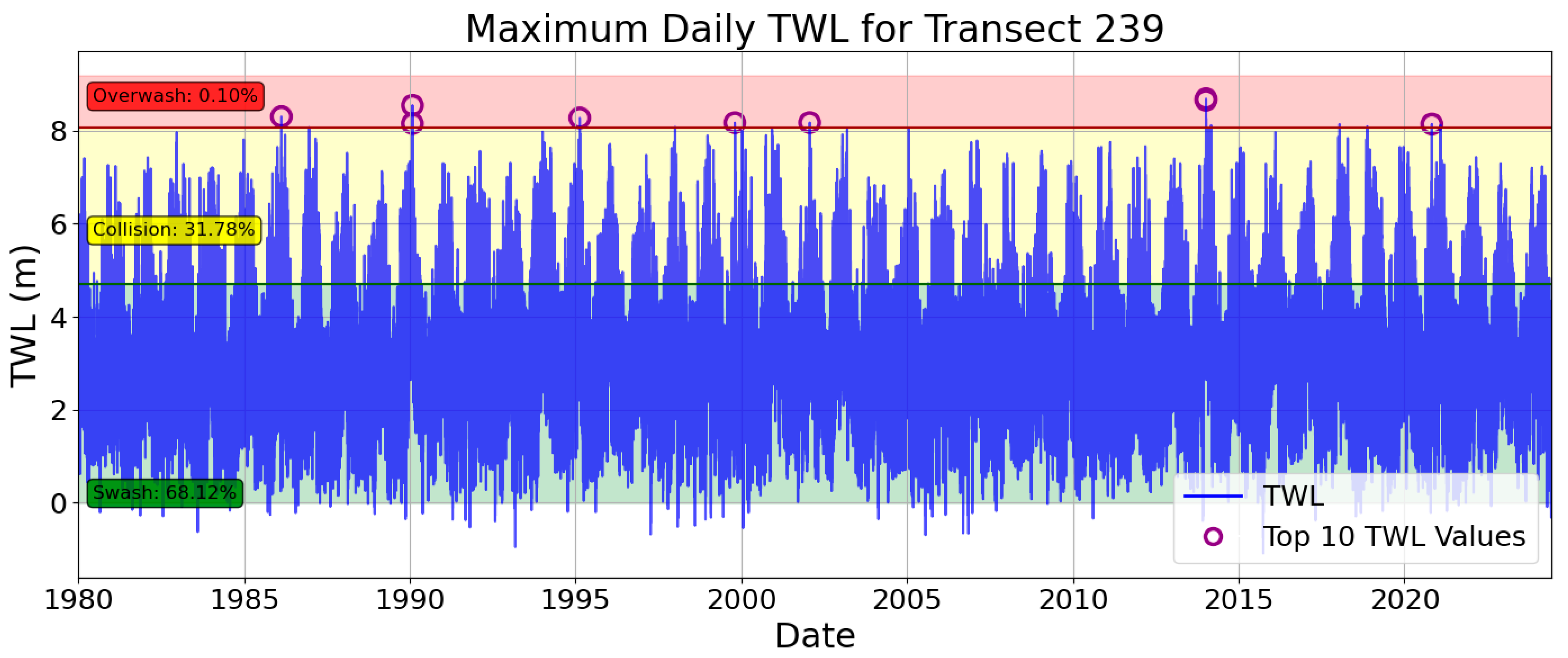
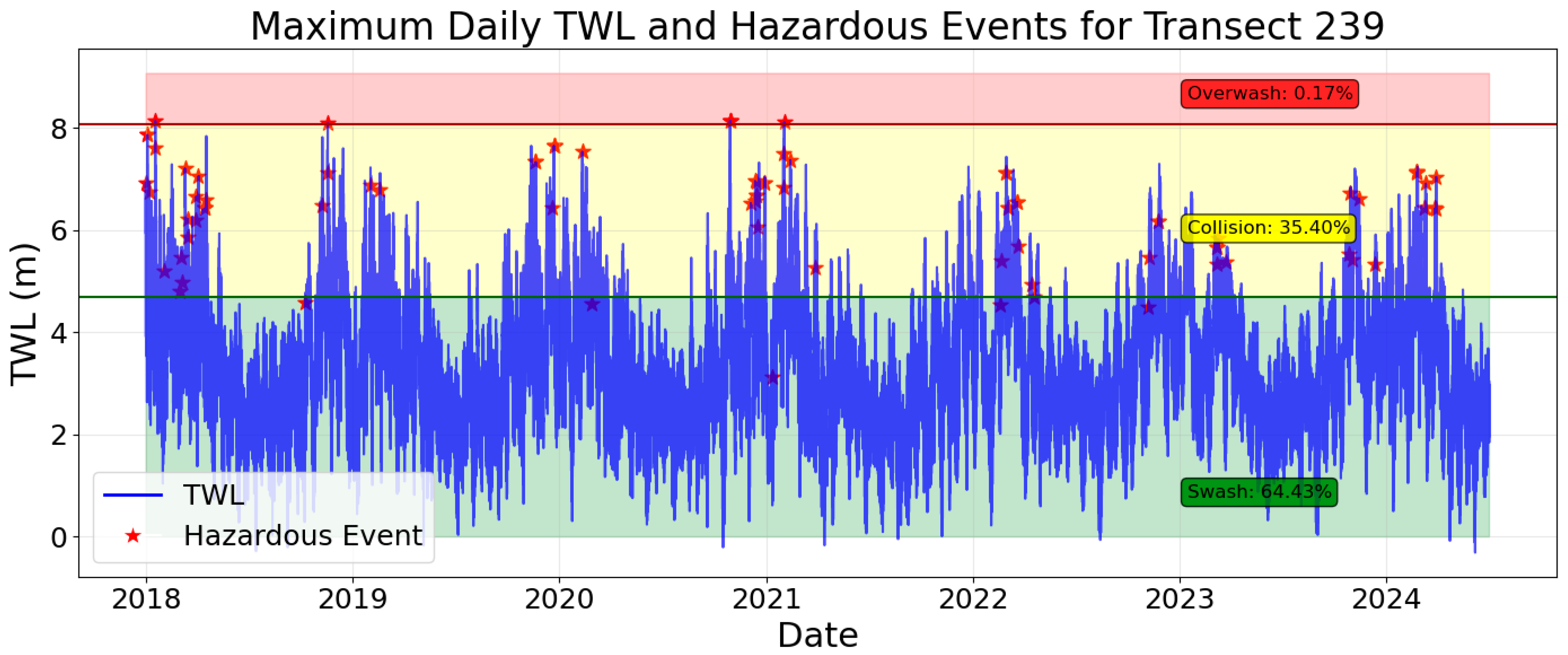
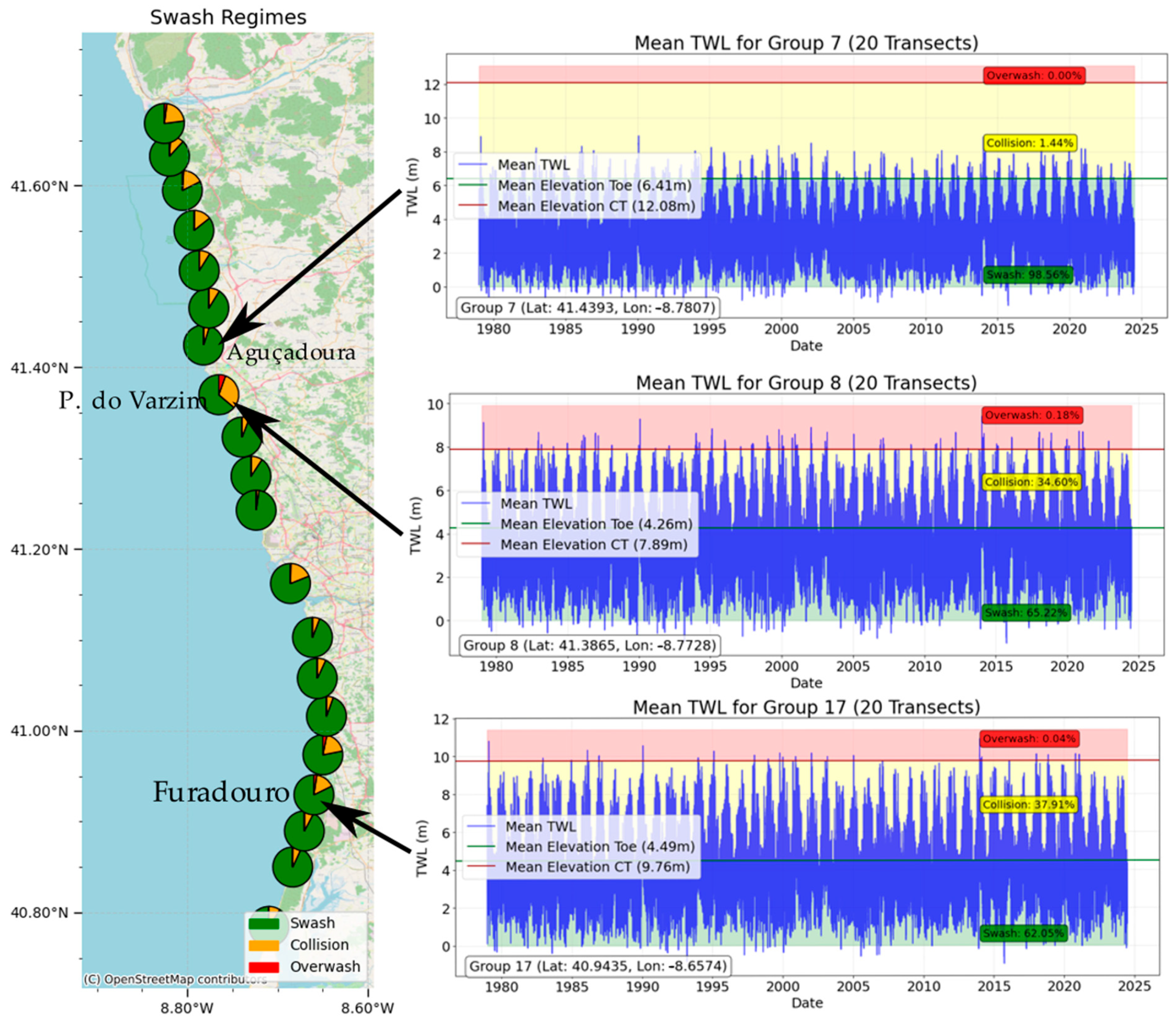
| Dune Toe Elev. (m) | Beach Slope | Dune Crest Elev. (m) | |
|---|---|---|---|
| mean | 5.1 | 0.101 | 9.7 |
| std | 1.2 | 0.045 | 2.2 |
| min | 0.4 | 0.027 | 4.3 |
| 25% | 4.5 | 0.076 | 8.1 |
| 50% | 5.2 | 0.094 | 9.5 |
| 75% | 5.8 | 0.116 | 11.1 |
| max | 10.0 | 0.540 | 15.7 |
Disclaimer/Publisher’s Note: The statements, opinions and data contained in all publications are solely those of the individual author(s) and contributor(s) and not of MDPI and/or the editor(s). MDPI and/or the editor(s) disclaim responsibility for any injury to people or property resulting from any ideas, methods, instructions or products referred to in the content. |
© 2025 by the authors. Licensee MDPI, Basel, Switzerland. This article is an open access article distributed under the terms and conditions of the Creative Commons Attribution (CC BY) license (https://creativecommons.org/licenses/by/4.0/).
Share and Cite
Carneiro-Barros, J.E.; Majidi, A.G.; Plomaritis, T.; Fazeres-Ferradosa, T.; Rosa-Santos, P.; Taveira-Pinto, F. Coastal Flooding Hazards in Northern Portugal: A Practical Large-Scale Evaluation of Total Water Levels and Swash Regimes. Water 2025, 17, 1478. https://doi.org/10.3390/w17101478
Carneiro-Barros JE, Majidi AG, Plomaritis T, Fazeres-Ferradosa T, Rosa-Santos P, Taveira-Pinto F. Coastal Flooding Hazards in Northern Portugal: A Practical Large-Scale Evaluation of Total Water Levels and Swash Regimes. Water. 2025; 17(10):1478. https://doi.org/10.3390/w17101478
Chicago/Turabian StyleCarneiro-Barros, Jose Eduardo, Ajab Gul Majidi, Theocharis Plomaritis, Tiago Fazeres-Ferradosa, Paulo Rosa-Santos, and Francisco Taveira-Pinto. 2025. "Coastal Flooding Hazards in Northern Portugal: A Practical Large-Scale Evaluation of Total Water Levels and Swash Regimes" Water 17, no. 10: 1478. https://doi.org/10.3390/w17101478
APA StyleCarneiro-Barros, J. E., Majidi, A. G., Plomaritis, T., Fazeres-Ferradosa, T., Rosa-Santos, P., & Taveira-Pinto, F. (2025). Coastal Flooding Hazards in Northern Portugal: A Practical Large-Scale Evaluation of Total Water Levels and Swash Regimes. Water, 17(10), 1478. https://doi.org/10.3390/w17101478










